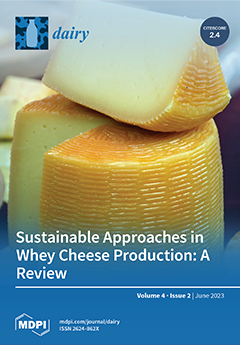In recent years, there has been an unprecedented increase in the demand for fermented dairy products due to medical recommendations and lifestyle preferences. Cultured buttermilk, as an ancient fermented dairy beverage, is an appropriate product choice in this context. This study presents a
[...] Read more.
In recent years, there has been an unprecedented increase in the demand for fermented dairy products due to medical recommendations and lifestyle preferences. Cultured buttermilk, as an ancient fermented dairy beverage, is an appropriate product choice in this context. This study presents a novel cultured buttermilk formulated by fortification with high protein microalgae
Spirulina platensis, thus making it valuable and attractive because of its antioxidant properties. The fermentation process, nutraceutical properties, and sensory characteristics of developed cultured buttermilk with various concentrations of
Spirulina (0.25, 0.5, and 1%) were compared with the control sample (0%
Spirulina buttermilk). Different concentrations of
Spirulina in buttermilk result in a significant increase in chlorophyll and carotenoid content, boosting its antioxidant properties. The study also evaluated the prebiotic properties of
Spirulina, thus, demonstrating its ability to promote a healthy digestive system. It was found that the addition of 0.25%
Spirulina was able to ferment the product more quickly and retained the sensory acceptability of the finished product. The protein content, free radical scavenging activity, chlorophyll, carotenoid, and total phenolic content of 0.25%
Spirulina-fortified buttermilk was 1.83%, 48.19%, 30.9 mg/g, 8.24 mg/g, and 4.21 mg/g GAE, respectively. Based on the results obtained, it was concluded that cultured buttermilk with a high nutritional value and functional health benefits can be developed by fortification with 0.25%
Spirulina as a natural ingredient.
Full article





